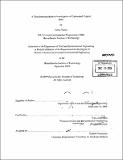| dc.contributor.advisor | Franz-Josef Ulm. | en_US |
| dc.contributor.author | Vanzo, James (James F.) | en_US |
| dc.contributor.other | Massachusetts Institute of Technology. Dept. of Civil and Environmental Engineering. | en_US |
| dc.date.accessioned | 2010-05-25T21:11:34Z | |
| dc.date.available | 2010-05-25T21:11:34Z | |
| dc.date.copyright | 2009 | en_US |
| dc.date.issued | 2009 | en_US |
| dc.identifier.uri | http://hdl.handle.net/1721.1/55260 | |
| dc.description | Thesis (S.M.)--Massachusetts Institute of Technology, Dept. of Civil and Environmental Engineering, 2009. | en_US |
| dc.description | Cataloged from PDF version of thesis. | en_US |
| dc.description | Includes bibliographical references (p. 273-291). | en_US |
| dc.description.abstract | Concrete, and in particular its principal component, cement paste, has an interesting relation with carbon dioxide. Concrete is a carbon dioxide generator-- it is estimated that 5-10% of atmospheric CO₂ comes from this source. Carbon dioxide is a concrete corroder-- it can penetrate into the porous concrete structure and cause great physical and chemical changes. Finally, a new engineering direction suggests the use of concrete as a carbon sequesterer. Carbon sequestration is the technique of containing large quantities of carbon dioxide in the fashion of waste control. Given the escalating quantity of carbon dioxide in our atmosphere, this technology is gaining increasing attention and may be implemented in cement paste-lined, defunct oil wells. Such a setup involves an interface between cement paste and large quantities of CO₂, and corrosion of the cement paste is inevitable. This would make carbon sequestration the first technology to employ carbonated cement paste as a structural material and, as such, requires a well-developed knowledge of both the processes and the product. The goal of this thesis is an investigation of the fundamental properties of carbonated cement paste. For a set of class G oil well cement pastes carbonated under wet-supercritical CO₂ and CO₂-saturated water, we find that the fundamental building blocks of the carbonated material are calcium carbonate, decalcified C-S-H, and silica gel. | en_US |
| dc.description.abstract | (cont.) The characteristic size of the calcium carbonate is below the micron scale, while the silica gel often reaches up to 10-20[mu]m in extension. The microstructure of these products is highly disordered. We arrive at these conclusions as the result of a dual chemical-mechanical analysis at the nanoscale in which statistical electron probe microanalysis (EPMA) and statistical nanoindentation analysis are employed. The development of a statistical EPMA method for cementitious materials is an original method of this thesis. | en_US |
| dc.description.statementofresponsibility | by James Vanzo. | en_US |
| dc.format.extent | 291 p. | en_US |
| dc.language.iso | eng | en_US |
| dc.publisher | Massachusetts Institute of Technology | en_US |
| dc.rights | M.I.T. theses are protected by
copyright. They may be viewed from this source for any purpose, but
reproduction or distribution in any format is prohibited without written
permission. See provided URL for inquiries about permission. | en_US |
| dc.rights.uri | http://dspace.mit.edu/handle/1721.1/7582 | en_US |
| dc.subject | Civil and Environmental Engineering. | en_US |
| dc.title | A nanochemomechanical investigation of carbonated cement paste | en_US |
| dc.type | Thesis | en_US |
| dc.description.degree | S.M. | en_US |
| dc.contributor.department | Massachusetts Institute of Technology. Department of Civil and Environmental Engineering | |
| dc.identifier.oclc | 612432822 | en_US |
